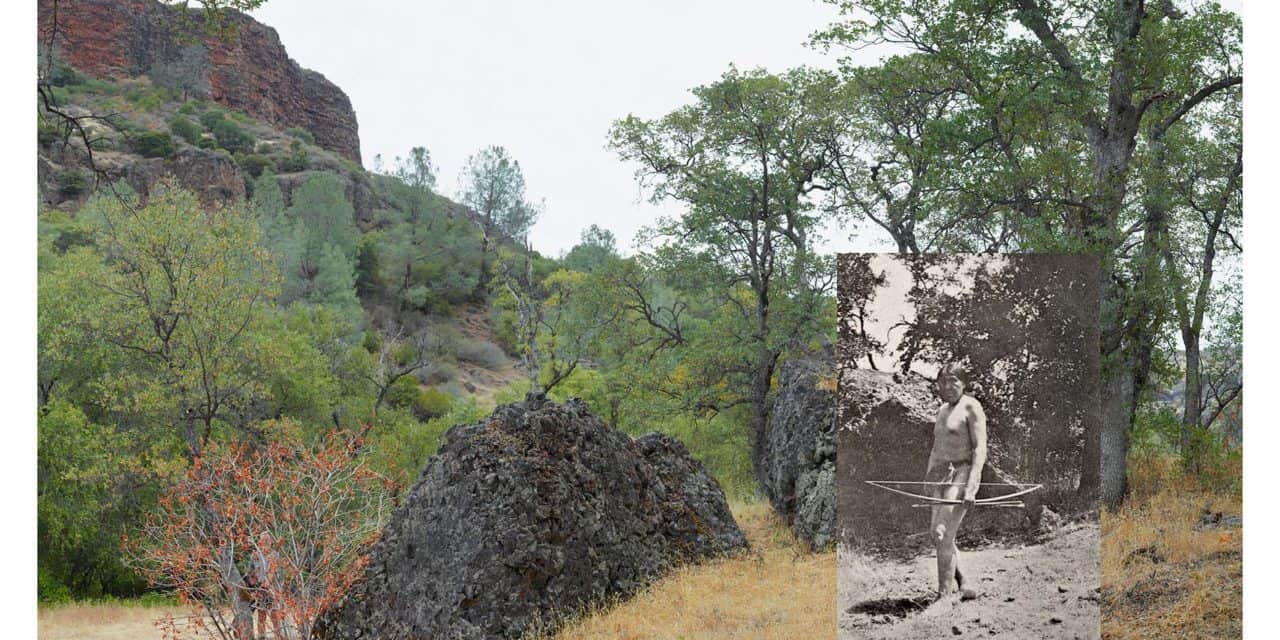In August of 1911 the man we all know as Ishi walked into Oroville. He was lonely, emaciated, and exhausted after having spent the last three years alone, being the last remaining member of the Yahi tribe. He was quickly taken under the wing of Alfred L. Kroeber who was an anthropologist. Ishi was taken to the Bay area where he worked as a janitor and was considered a “research assistant”. It was in 1914 when Kroeber took Ishi against his wishes back to Deer Creek in an effort to see first hand how Ishi lived in that environment. It was during this trip with Kroeber, Ishi’s physician Saxton T. Pope, and Kroeber’s associate T.T. Waterman, that some of the most iconic photos of Ishi were taken. It was these photos that Byron Wolfe would turn to for his most recent exhibition.
Byron, currently the program director and graduate advisor, teaches at Temple University in Philadelphia. He spent the previous 14 years as a professor of photography and design related courses at Chico State. It was there in Chico where the idea for the Ishi project originated. “The Ishi piece came about because I had a book called ‘Ishi in Two Worlds’, it was published in 1955. It’s a book that my wife had inherited from her grandparents. I didn’t really know it at the time when I moved to Chico but I later came to understand that Ishi lived just north of Chico for the majority of his life. I have a history with working with historic photography, typically photographs from the 19th century, whereby I investigate their stories, their origins and their locations. And I make new pictures in response to this.” Byron explained.

In this project, Byron has retraced the origanl photos taken of Ishi upon his return to Deer Creek in 1914 and combined them with present day photographs of the same area. When you look at the picures Byron’s taken and how he incorporates them seamlessly with the originals, it leaves you in awe. I’m not sure if it’s the power of seeing Ishi in his world and in ours or what but I am just completely mystified by these photos. The concept of mashing up old and new photographs is a technique Byron has used a lot of times in the past. “It’s just a way of working that I like to bring history into a contemporary conversation and also to provide a kind of frame work to try to look at where we are today.” He said.
One of Byron’s favorite photos from this project is a panorama that took him around 5 hours to make. It’s of Ishi swimming and Salmon fishing in Deek Creek. “I like that one partly because of how there’s almost like a narrative scroll where you see Ishi moving through Deer Creek. I like how it represents the space within Deer Creek and it also includes collaborators Heather and Troy in it who are setting on the beach reading and writing. And the beach has all these little details, all these little photographs, pictures of paper that are scattered all along the beach right beside Deer Creek. Those are photographs of Ishi placed at the location where they were made back in 1914.” Byron said of the photo. “He’s standing on this big really interesting Basalt rock that is 15 million years old. So I just like all the different kind of layering of the experience, time, and history in that picture.”

Ishi has a special place in the heart of most Northern Californians and those who know his story. Since he “emerged from the wilderness” in 1911, he’s been the topic of countless articles, books, and there’s even a film, “The Last of his Tribe” staring Graham Greene and John Voight. Something about his plites and perserverance in this life draws people in and resinates with their soul. “The story itself is so compelling. Ishi being (there are arguments about this) probably the last of his group, the only one who spoke his language. To be the last of something, that’s a powerful human experience but I think fortunately most of us don’t have to go through. But his story of leaving his life, world and culture and entering into a completely new one, in the way that he did, was just so resilient.” Byron said. “It’s this really complex story of loss and melancholy- optimism and resilience. I think that’s why people respond to his story and it’s a really complicated story as well. I’m not even touching on all the different facets of it, which continued after he died. But it just seemed like such an interesting thing to explore to understand the past and think about our current relationship with this place and story.”

The Ishi project is one section of the exhibition and Byron is only one of the contributors. The full exhibition covers the topics of Mt. Tehama, Chico’s allusive Hooker Oak tree, the Columbian Mammoth’s molar that was found in Bidwell Park in 2000, and of course Ishi. Working alongside Byron are sculptor Sheri Simons, writer Heather Altfeld, Volcanologist Dr. Rachel Teasdale, philosopher and poet Troy Jollimore, and designer Oliver Huntin. They are all still working on elements of the exhibition but the full project will be shown in Chico in October of 2017. Because of the complexity of the full project it’s taken the collaborators about 7 years to finish. So do yourself a solid and make sure you see this show in person, it’s not going to disappoint, as Byron described the project “It’s all designed to kind of rethink the way we understand these sort of iconographic people and places in the region.”
For more information on Ishi you can check out our past article, “A CIVIL MAN: THE STORY OF ISHI” on our website and if you are interested in
Byron and his work you should visit his website (www.byronwolfe.com). From there you can sign up to recieve his email updates to keep tabs on his work along with news about this falls Chico exhibition and all that jazz.












